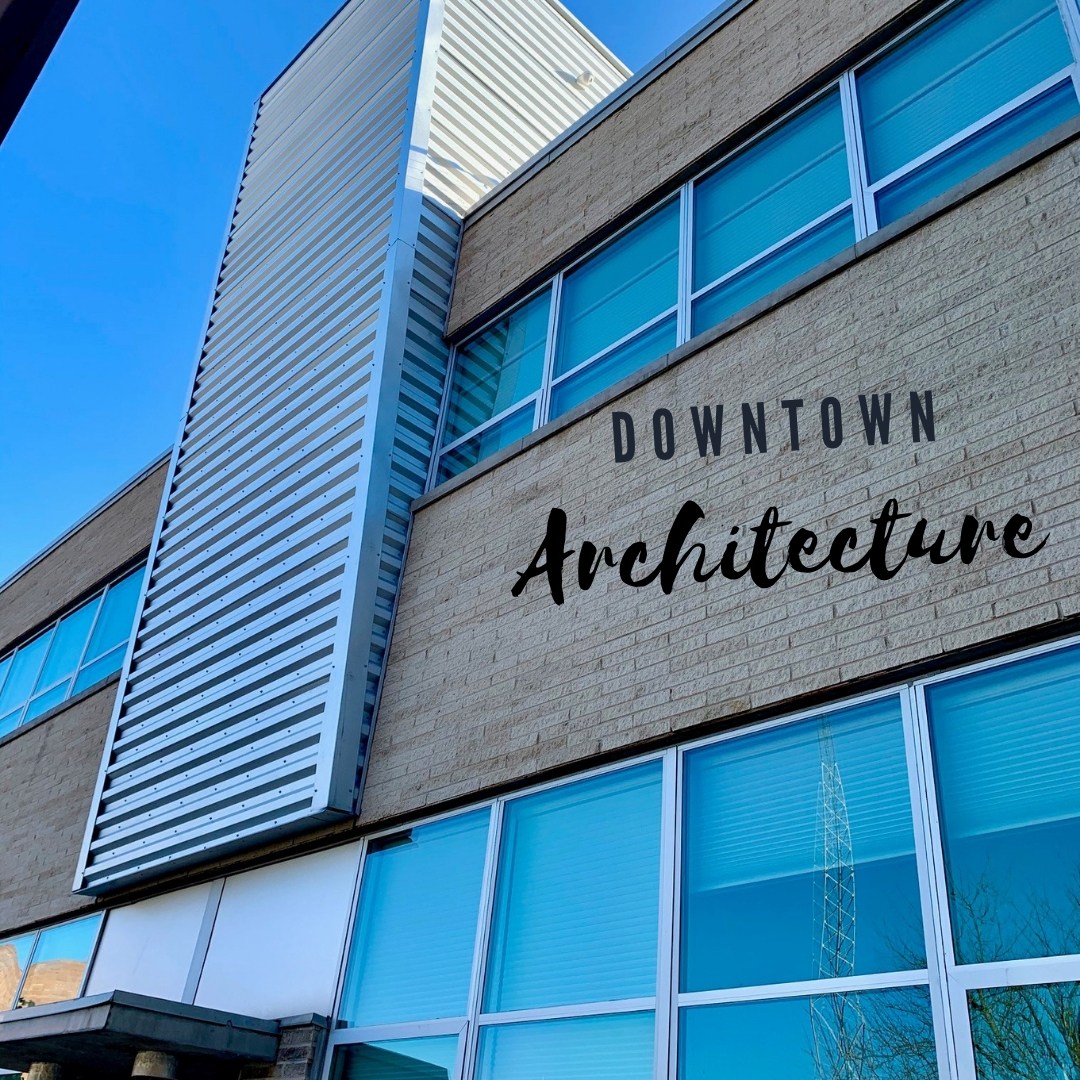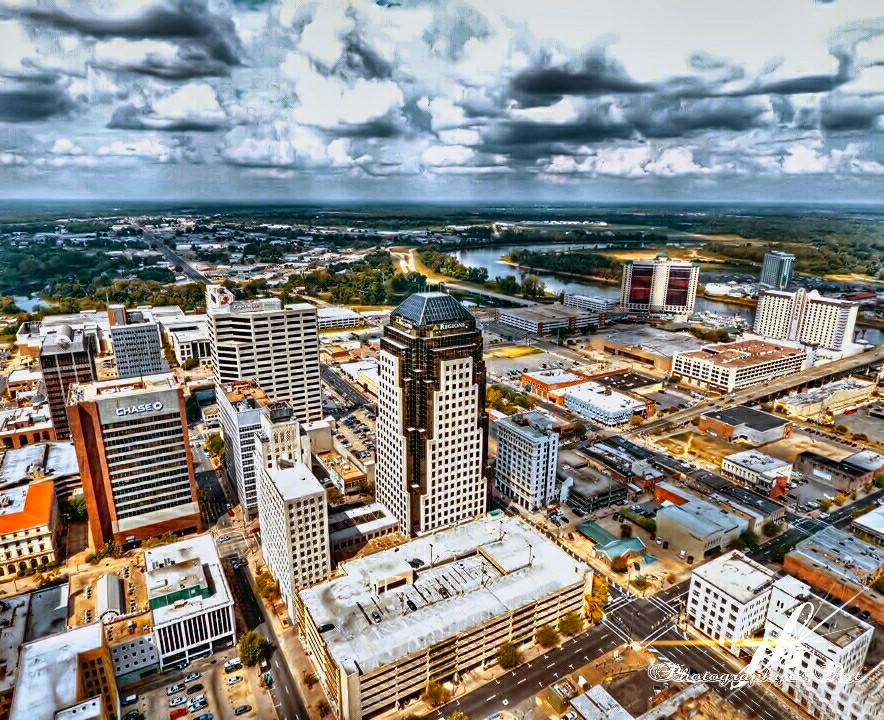
Beautiful photo of the downtown skyline by Josh Brittian, JB Photographic Arts, LLC.
The downtown Shreveport Commercial Historic District is nothing if not interesting; filled with all kinds of architectural types. From two story office buildings constructed to house cotton ‘factors’ (merchants) in the late 1800’s to multi-story steel and glass high rises built from the 1950’s to present, downtown’s style runs the gamut. What is important to remember is that everything that you see today sits on a site where there was something else…or maybe several something else’s!
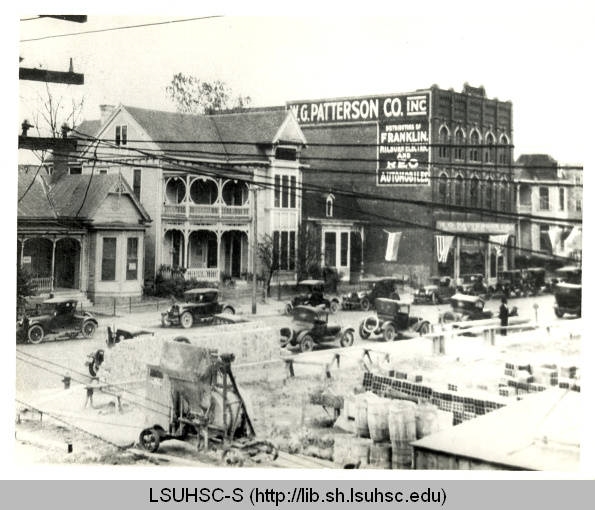
600 block of Texas Street in the early 1900s. The building with WG Patterson Co. on it still exists today. Many of our earliest remaining buildings are Italianate in style.
Shreveport’s historic downtown was first built out of wood, and boy, did it burn, baby, burn. Kerosene and wood stoves and bar fights were not a good mix. In the 1920s, downtown really came into its own during one of Shreveport’s ‘Golden Ages’ of construction.
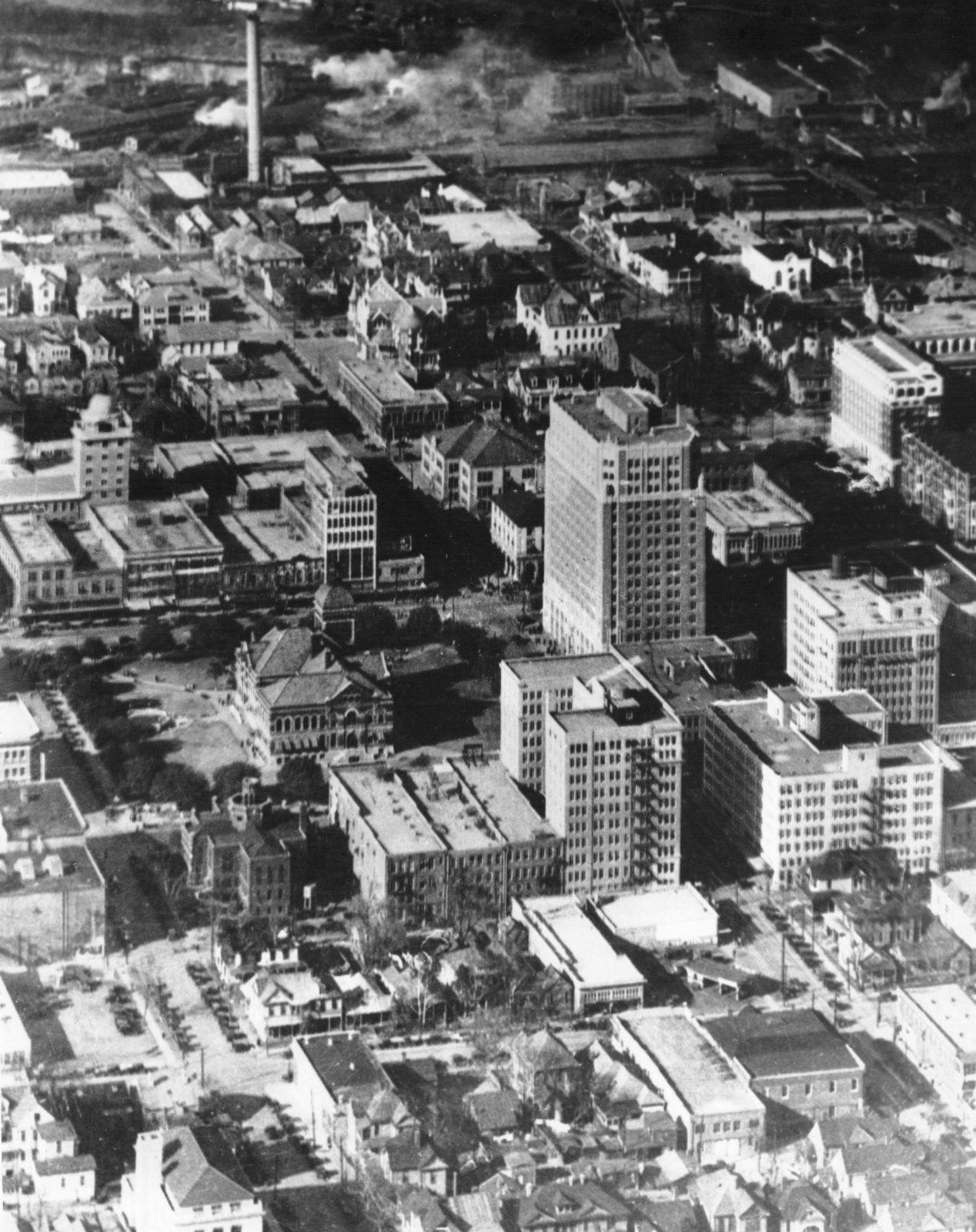
A number of important buildings that we still use were constructed in the 1920’s. This includes the Slattery Building, the downtown YMCA, the Central Fire Station (now ARTstation), the Fiebelman’s/Sears Building (now Lofts at 624), the Andress Ford (now Andress Artist and Entrepreneur Center), the Strand Theatre and others.
When oil was struck in north Caddo Parish and elsewhere and money started flowing, locals built soaring edifices and named them after themselves. Think Slattery Building, Johnson Building, Lane Building and others. These families invested in something that is still around to be enjoyed and admired 100 years later, and we are very thankful for that.
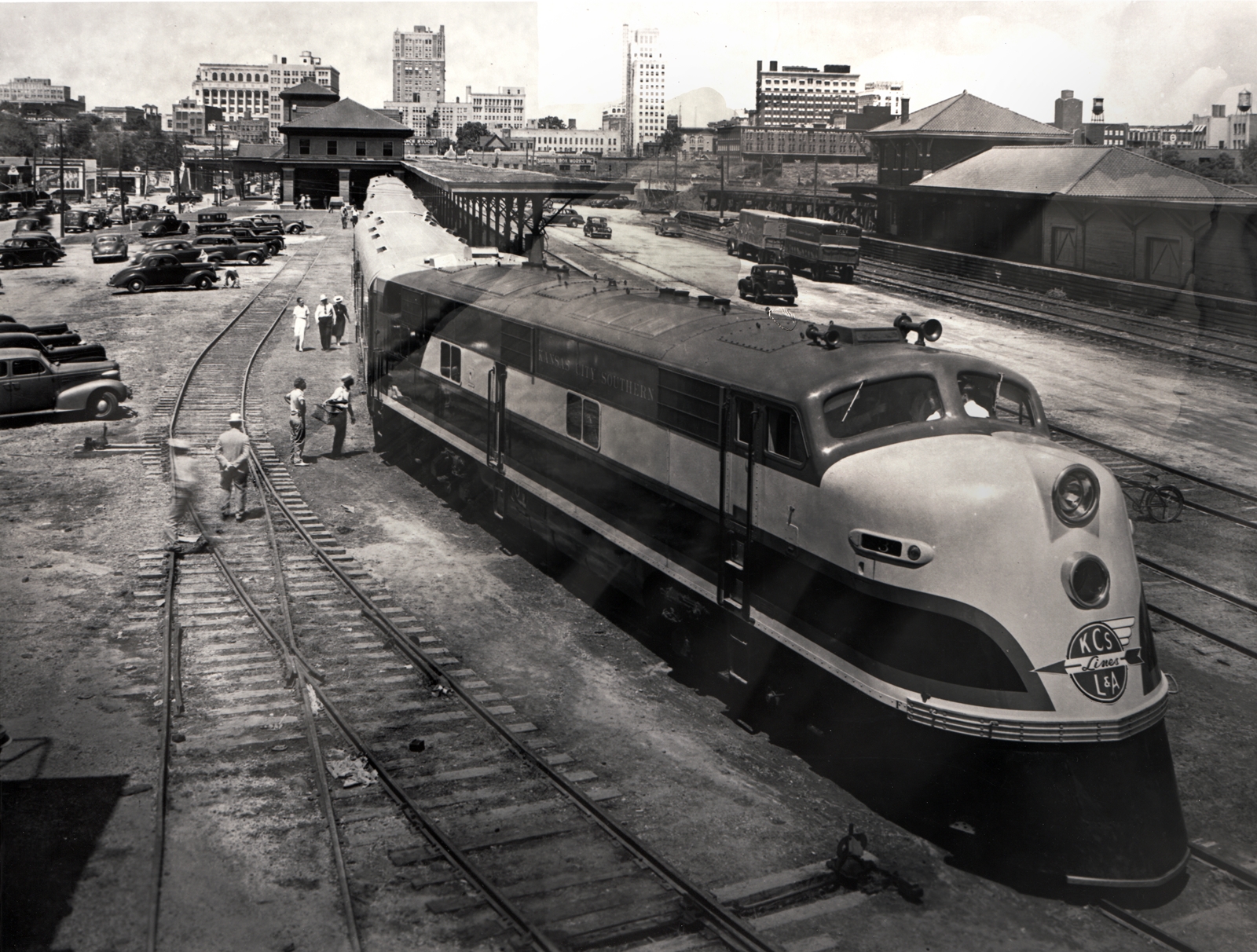
The famous Southern Belle railroad at Central Station on Marshall Street. Downtown’s skyline is in the background.
During the last century, downtown Shreveport was also a hub for numerous railroads and the many passenger trains that came through each day created a need for hotels and boarding houses, restaurants, and yes, helped fuel the largest legal Red Light District in the state, larger even than New Orleans’ famed Storyville. Downtown’s Red Light District, whose boundaries were roughly Caddo to Travis, west of Common Street, is where Shreveport’s most famous madam, Annie McCune, plied her trade.

The original Illinois Central Freight Station, now offices at Festival Plaza.
Two of the four downtown train stations, old Central Station on Marshall Street and the Illinois Central Freight Station in Festival Plaza still exist, and the old Arlington, Jefferson, Creswell, and Hunter Railroad Hotels are still standing.
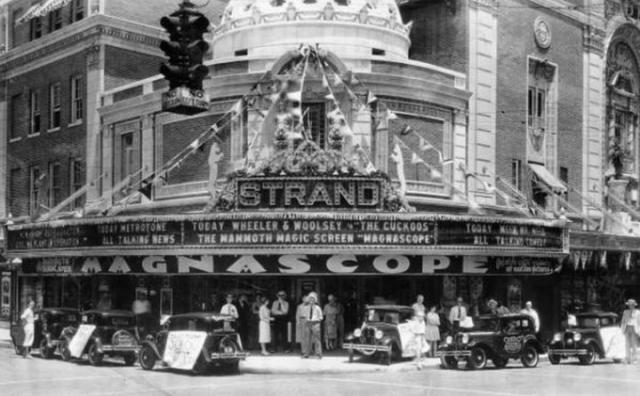
We are also lucky to be the birthplace of Abe and Julian Saenger, pharmacists by training, but purveyors of movie magic by desire. The Saengers are responsible for the construction of many of the buildings in the 600 block of Milam Street as well as the fabulous Strand Theatre. They started the Saenger theater chain, which later sold to Paramount. There is so much more history to share, and many details can be found in the buildings left behind. Do some exploring on your own and be sure to look toward the heavens when you do. Much of the amazing architectural detail is in hidden spaces and high places; toward the top of many facades is where you will see how craftsman of a century ago really left their marks.

Look up and be amazed! Some of the most ornate architectural details are near the rooflines.
Following are some of the architectural styles you will see in downtown Shreveport.
Downtown Architectural Styles and Building Locations
Neo-Gothic
Skyscrapers and churches of the 20th century share many of the same characteristics as early medieval structures. In the early twentieth century, Gothic Revival ideas were applied to modern buildings and homes in the United States. These buildings were called Neo-Gothic. The style is most memorably known for its use of strong vertical lines and ability to create a powerful sense of height. Pointed arches were commonly used to embellish windows and entryways. Other traditional Gothic elements include the use of steep gables, ribbed vaulting, tall towers, and an overall dramatic looking appearance.
Example: Slattery Building, 509 Marshall St.
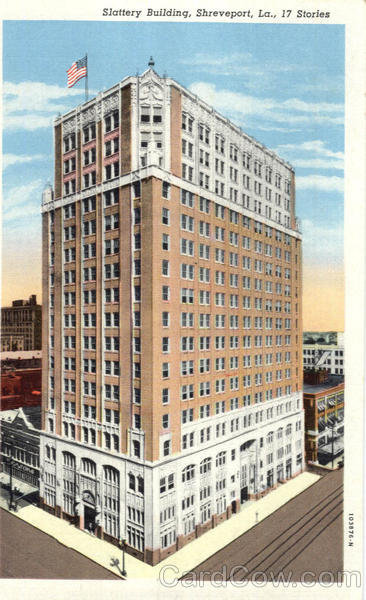
The Neo Gothic Slattery Building at the corner of Marshall and Texas Streets.

Italian Renaissance Revival
Italian Renaissance Revival was a style popular in the United States from around 1890 to 1930. It was inspired by early 16th-century Italian Renaissance architecture, especially from palazzos or palaces found in cities like Rome, Venice and Florence. The most predominant feature of this style is its imposing scale and formal design incorporating classical details such as columns and round arches and balustrades. They are usually masonry/stone construction. One version of the style features a large rectangular building, usually three or more stories in height, topped by a flat roof with a crowning balustrade.
Examples: Central ARTSTATION- 801 Crockett, Shreve Memorial Library-424 Texas St., YMCA- 400 McNeil.
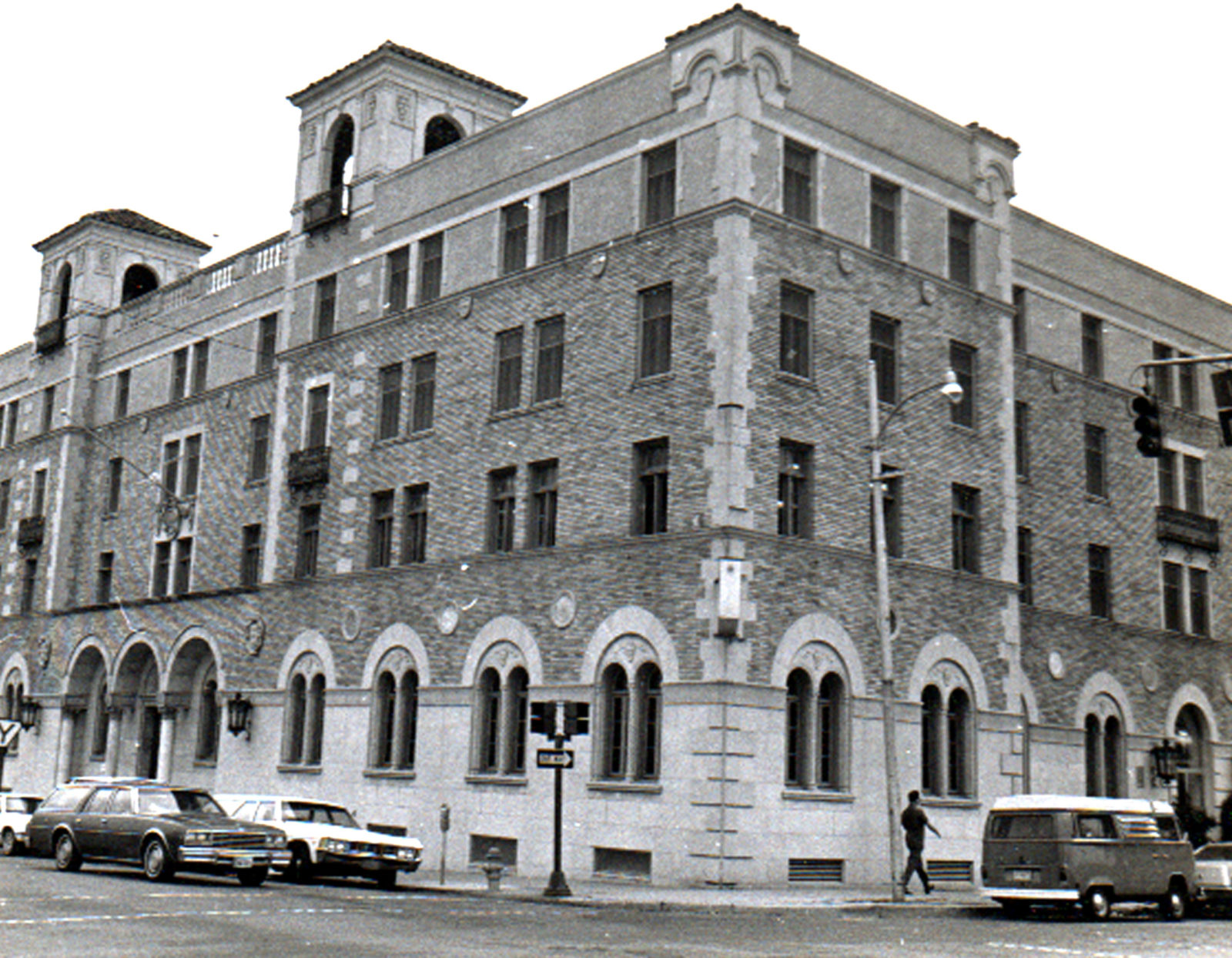
The Italianate YMCA building in the 400 block of McNeil St. Note the arched windows, the balustrade (railing) at the top and the masonry/stone.
Art Deco/Moderne
Downtown Shreveport has 11 different examples of this.
Art Deco– is characterized by vertical emphasis and the use of new materials like chrome, stainless steel, and opaque plate glass. Designs are geometric and use shapes like pyramids, chevrons or zigzags, and lightning bolts. Buildings sometimes include stylized figures of waterfalls, sunrises and mythological figures.
Examples: Old Salvation Army Building- 710 Crockett St. Hunter Building-900 Market, Andress Ford-700 block of Crockett, former Commercial National Bank building (now Regions Bank), 333 Texas & Medical Arts Building ( now Travis Place), 624 Travis St.
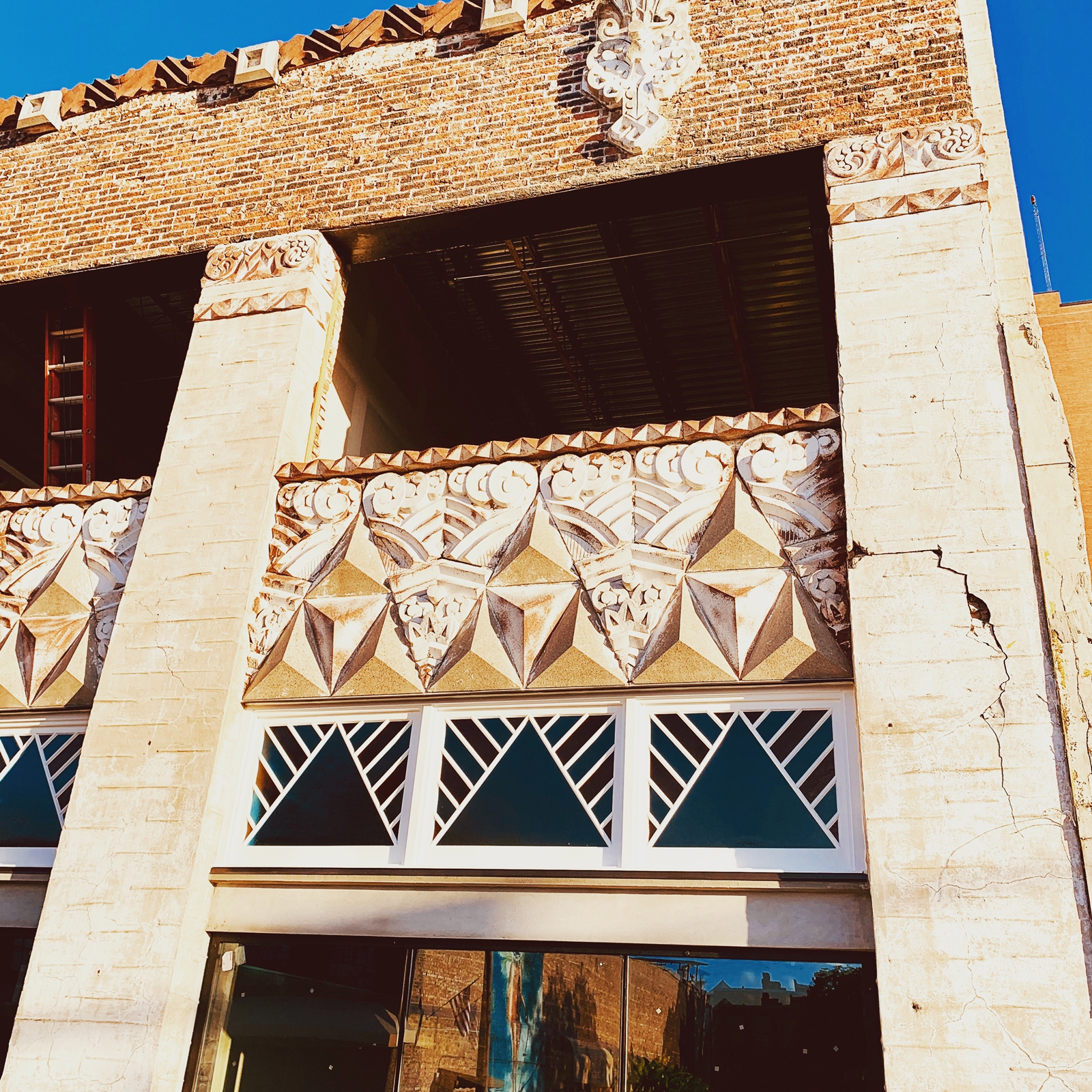
Close up of architectural detail of the Andress Ford building, 717 Crockett St.
Streamlined Art Moderne– These buildings have flat roofs, and bands of windows with a horizontal emphasis. Some buildings of this style have simple pipe balustrades, panels of glass block windows, curved canopies, or aluminum or stainless steel detailing. This style was heavily influenced by advancements in the industrial design of ships, planes, railroad engines and automobiles. The smooth walls have very little surface ornamentation, rounded corners and curved glass.
Example: PPG- 525 Cotton

Moderne PPG/PPW Building on Cotton St. Smooth walls, rounded corners and glass block windows.
Mid-Century Style
Mid-Century Modern denotes a style of design that was popularized from the 1930s through the 1960s. Characterized by a contemporary, seemingly futuristic aesthetic and an emphasis on function, the Modern movement influenced many types of design. There are multiple Modern categories, from Art Deco to International. Flat roofed, asymmetrical and with bands of windows set into a rectangular form, International style buildings were a dramatic departure from past eras. Many European architects came to the United States in the period preceding World War II, bringing their new ideas about modern design with them. In the 1930s American architects began experimenting with the International style, building upon the early 20th century American trends like the Commercial, Bungalow and Prairie styles, and the development of skyscrapers.
Beck Building- 400 Travis & Petroleum Tower- 415 Edwards, Mid South Towers, 416 Travis.
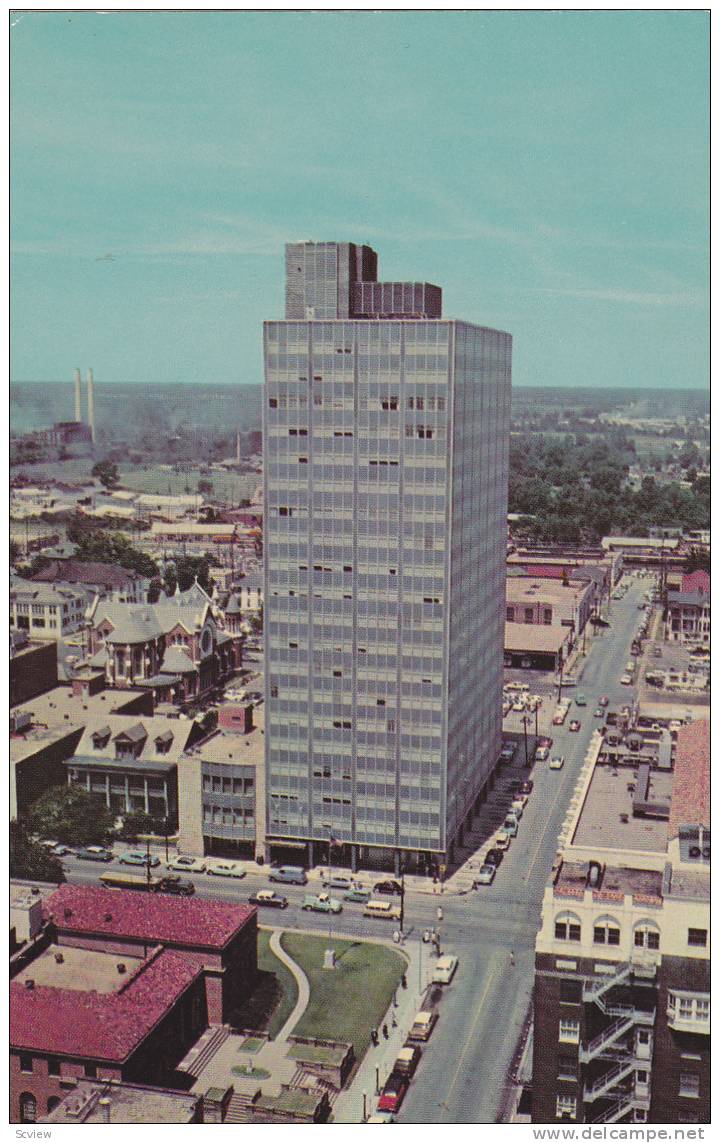
The Mid Century Beck Building, also known as a glass and steel skyscraper
International Style
International Style describes a type of design that developed mainly in Germany, Holland and France during the 1920s before spreading to America in the 1930s. Common characteristics of International Style buildings are rectilinear forms and light, taut plane surfaces that have been completely stripped of applied ornamentation and decoration.
Examples: Old YWCA ( now Marlene Yu Museum), 710 Travis St. Former BellSouth Building, now Southern Belle, 627 Crockett.
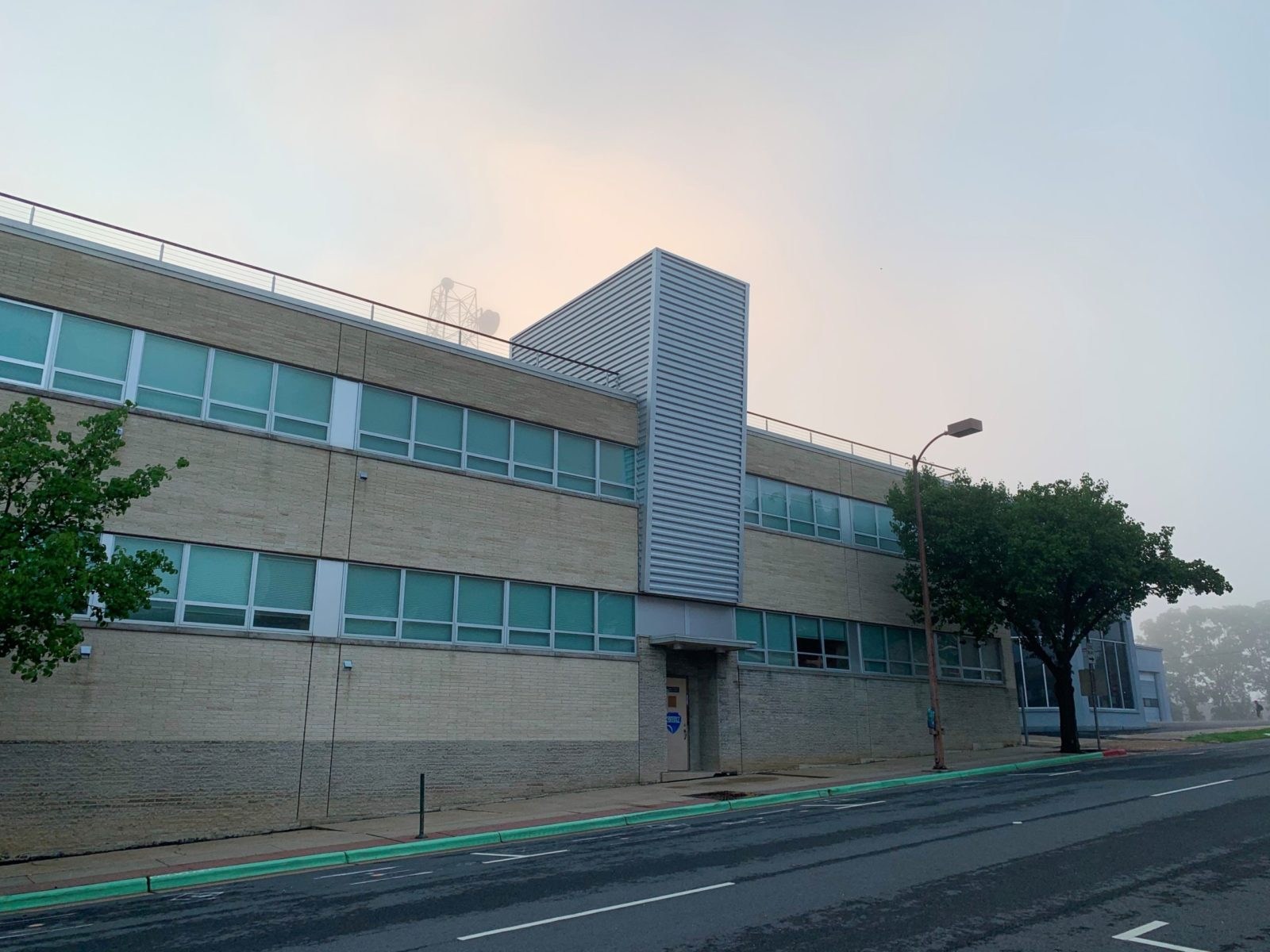
Former Bellsouth building at 627 Crockett.
Italianate
Italianate architecture features elements such as overhanging eaves where the roof meets the walls; and decorative supporting wooden brackets on door and window hoods.
Examples: Justin Gras Building- 525 Louisiana & Harkey Building- 712 Milam, 600 Commerce St.
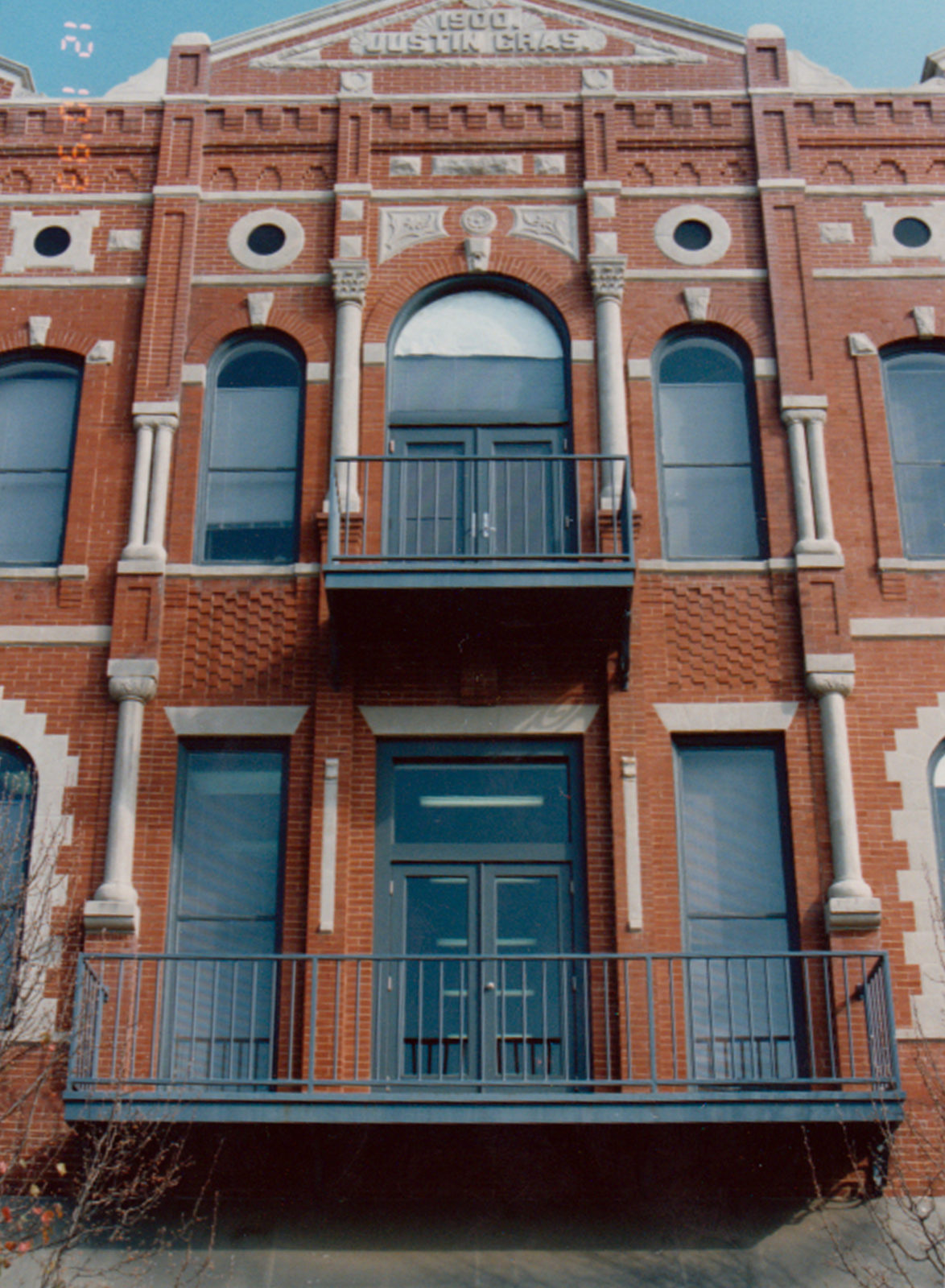
Justin Gras Building, 525 Louisiana
Earlier Italianate
Examples: 600 block of Commerce, 519 Spring, & Spring Street Historical Museum Former Talley’s Bank)-525 Spring
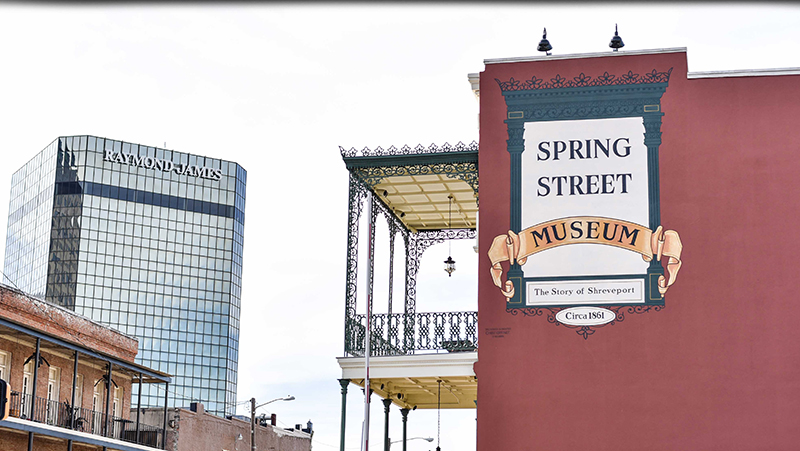
Spring Street Museum, 525 Spring St.
Classical Revival
The style is characterized by severity of appearance and solidity, with orders being used in a structural rather than a decorative manner. Classical Revival loosely describes architecture employing classical elements, but that is less severe in appearance than Neo-Classical architecture. The grandest downtown example is considered to be the Caddo Parish Courthouse.
Examples: Caddo Parish Courthouse, Old Municipal Building-724 McNeil St., First United Methodist Church, old Sears Department Store (now Lofts at 624), 624 Texas St. and the Shreveport Mutual Building Association, corner of McNeil and Crockett.

Old Municipal Court Building, McNeil Street.
Beaux Arts
A subgroup of Classical Revival, Beaux-Arts architecture became part of the late 19th century American Renaissance movement. Beaux Arts is characterized by order, symmetry, formal design, grandiosity, and elaborate ornamentation. Architectural characteristics include balustrades, balconies, columns, cornices, pilasters, and triangular pediments.
Examples: Allen Building -corner of Texas and McNeil, Scottish Rite Temple- 725 Cotton, B’Nai Zion Temple, Municipal Auditorium (some put this building in a heavily ornamented Art Deco category), the former Wray Dickinson Building (now Origin Bank) at 308 Market St.
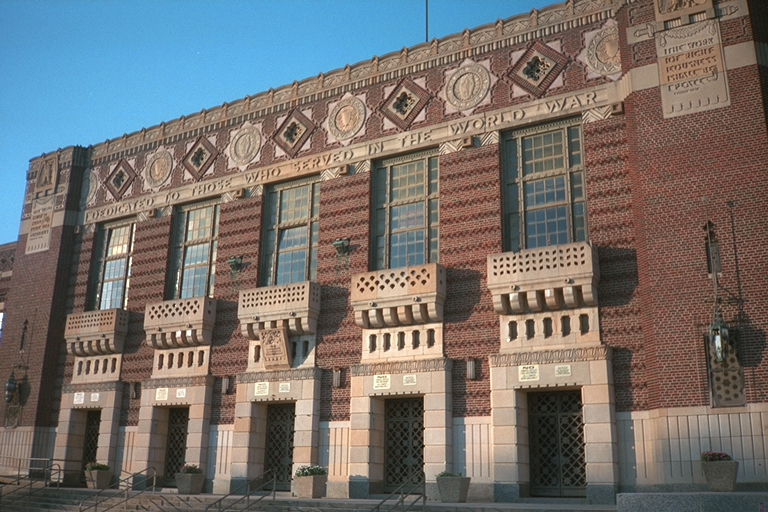
The heavily ornamented Beaux Arts Municipal Auditorium.
Neo-Baroque
Another subgroup of Classical Revival, Neo-Baroque is used to describe architecture which displays important aspects of Baroque style, but is not of the Baroque period proper—i.e., the 17th and 18th centuries. Baroque architecture has several identifying characteristics, including curving forms and walls that seem to undulate, or move in waves. Surfaces of structures will often display a massing of elements like columns and sculptures, and volutes, or decorative spiral shapes.
Example: Strand Theatre-619 Louisiana
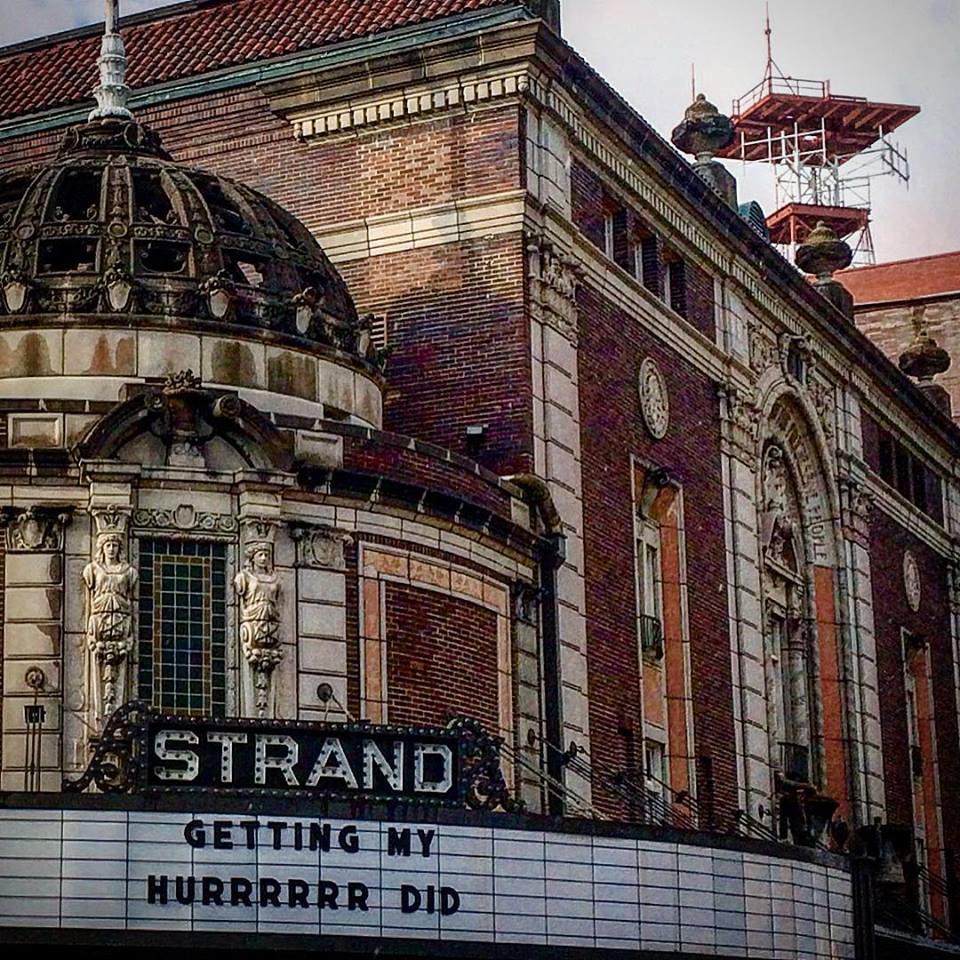
Skyscraper
Such as Chicago- Style Tall Buildings.
The Standard-509 Market, Johnson Building-412 Milam & Lane Building-620 Marshall

The former Commercial National Bank building, now The Standard at 509 Market St.
Warehouses
Lee Hardware, 719 Edwards & Interstate Wholesale Furniture, 816 McNeil

Former Oilfield Supply, Hughes Tool Co., Interstate Furniture at 600 Lake St.
Downtown has a little of a lot. Come downtown, walk or drive around and try to identify our different architectural styles!

